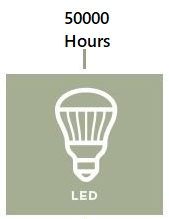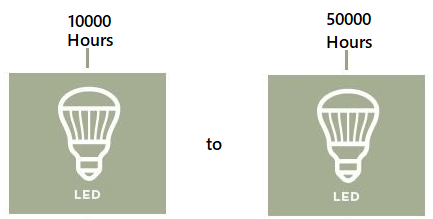How To Determine The Life Expectancy of an LED Light?
Before we take a look at the life expectancy of an LED light and the factors that affect it, let’s try to understand how they calculate the average life expectancy of an LED light, to begin with. The LED lights have a very simple working principle. When electric current passes through the semi-conductive light-emitting diodes, it starts emitting protons that are visible to us as light. Traditionally, the incandescent bulbs were determined by calculating the time it takes for half the bulb in a batch to fail compared to the whole batch. But, this method is not comprehensive enough to determine the actual lifespan of an LED light as these lights do not fail that easily. Instead, the LED lights fade away gradually over time which makes the process even longer and tedious.
Instead of waiting around to let the LED lights fail completely, their life expectancy is determined when an LED reaches 70% illumination level compared to its original intensity. The rest of the procedure is similar as the results are concluded when 50% of LED lights of a batch have collectively reached the 70% light intensity mark. Depending upon the type of LED, the results vary between 10000 and 50000 hours ARL (Average Rated Life). The life expectancy of an LED light is represented in technical terms such as L70, L50, etc. In this terminology, the number represents the percentage of luminosity available on the LED compared to its rated output. For example, an LED light with a life expectancy of L70 of 50000 will fade up to 70% of its original capacity over the time period of 50000 hours. Logically, the LED light with an L50 rating for the same amount of hours will fade faster as it will fade up to 50% of its original capacity.
To understand the differences between the life expectancy of different types of LEd lights, we need to take a look at different factors that have an impact on the life expectancy of LED lights.
Major Factors That Affects an LED Light’s Lifespan
If you take a look at a damaged incandescent bulb, you can easily find out the reason for the failure. In most cases, it is due to external damage as the traditional lights are not durable by design. These lights would either get failed because of damage to the filaments. But, it is not that easy in the case of LED lights.
How To Waterproof LED Lights How long do LED lights last Best Wireless LED Lights
The LED lights nowadays are very compact in design that makes it difficult to find the root cause of failure as all of the minuscule components and connections cannot be seen by the naked eyes. On top of that, the LED lights do not have any independently moving part which can get damaged separately. Thus, all types of LED lights grow dimmer as time passes rather than turning off completely at once. Here are some of the common factors that damage the LED lights over time until eventually, they are of no use. By understanding these factors in detail, you can easily find out the potential threats for your LED lights and apply some solution to avoid failure on your side.
Material and Manufacturing Defects
This is the most common type of problem as it is very hard to avoid in mass production companies. The LED lights are designed with a crucial set of components that play an important role in its working. The active region of an LED light consists of several different components that operate simultaneously to create light. If there is a material or manufacturing defect on these parts, the LED lights will fail faster than expected. Even if the defect allows the LED light to turn on in the beginning, these parts have a higher chance of getting damaged because of heat and electricity. Hence, it will sooner or later cause the LED to fail. Most premium LED manufacturers take care of these problems by selecting high-quality and durable materials for the construction of the LED. Also, the problem can be avoided by eliminating hurdles in the manufacturing process to increase the overall lifespan of an LED light.
Electrical Overload
Electrical overload can potentially damage all types of electronic devices whether it’s your TV, refrigerator, washing machine, or air conditioner. If the large and expensive devices are not safe from electrical overload, the LED lights are certainly not an exception for this. In the case of LEDs, you will face EOS (Electrical Over Stress) which is caused when the input power on an LED light exceeds its design limit. There can be many reasons for electrical over-stress. It can be caused by human error, damaged power supply units, Damaged onboard PCB of the LED lights, material defects, etc. When a surplus amount of electric current is suddenly passed through the light-emitting diode, it burns out tremendously faster. Therefore, you will see a sudden and brighter glow in the LED lights before they get damaged. Electrical overload is an external factor that can be avoided by simply installing a stabilizer for your home or workplace. Even LED manufacturers introduce a static suppressor on their LED devices that dampens the incoming power and minimizes the hazard for the LED light.
Overheating
The main working principle of the incandescent bulb was the illumination of filament due to increased heat on the filament caused by constant electric flow. As constant heat slowly introduces permanent deformation in metals, the incandescent bulb would fail much quicker. The LED lights on the other hand operate on a much lower temperature level as the main components of the LED light do not heat up at all. Although, a slight rise in temperature still occurs in the light-emitting diode as it is a semiconductor that has a natural resistivity to the flow of current. This excessive heat acts against the LED light and affects its lifespan drastically. Apart from that, external heat sources also play an important role in these matters. If the LED light is placed near an external heat source, its core semiconductor does not reject heat easily which reduces its lifespan. Hence, you can take this factor into account next time you are installing LED lights to increase the overall lifespan of the LED lights.
What Is The Average Life Expectancy of an LED Light?
Now that you know some of the major factors that affect the life expectancy of LED lights, let’s find out the general life expectancy of different kinds of LED lights. As there are many different types of LED lights available in the market, there cannot be a definitive answer to this question. Also, due to the differences in construction and performance of different LED lights, the range of average life expectancy is very wide. Following the range, you can determine whether your LED light will operate flawlessly for 10 years, 5 years, or 1 year which is not a very decisive answer. Generally, the average lifespan of an LED lights falls between 10000 hours all the way up to 50000 hours.
While there is not a definitive answer for the average life expectancy of an LED light, we can assure you that it’s still an exceedingly better option compared to traditional light bulbs that consume more power and have an average life span of 1000 to 5000 hours.
Conclusion
We hope that you are satisfied with the information available in our article today about the life expectancy of an LED light. Here, we have presented a brief discussion about the average life expectancy of an LED light, how it is calculated and what factors affect the lifespan of an LED light. This information will be surely useful for you in the future as you will be able to choose a perfect option that guarantees longer reliability and lifespan. If you have any queries regarding the information available here, you can reach us via the comment section. Comment * Name * Email * Website
Δ








![]()